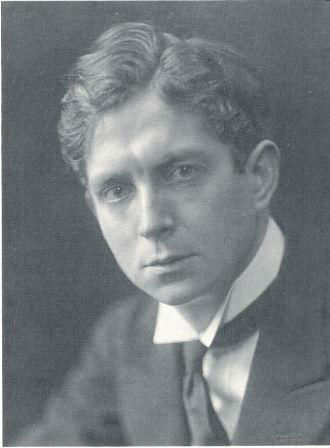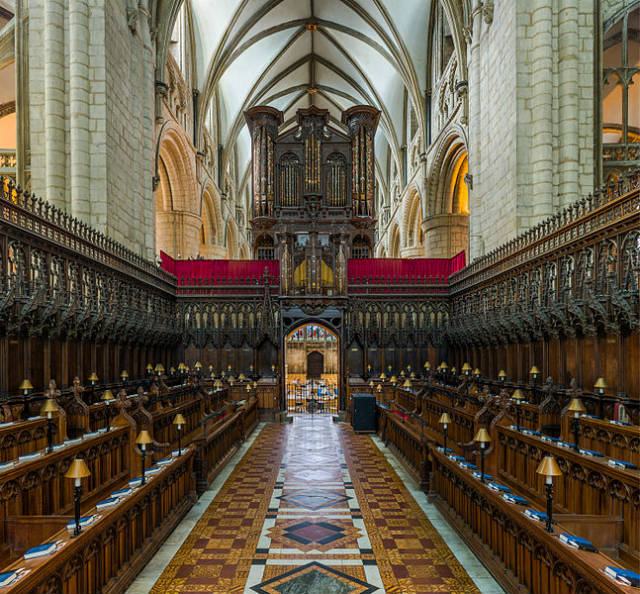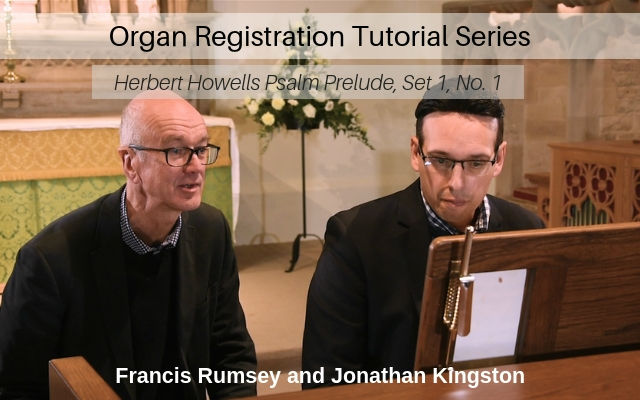In the third tutorial in our Organ Registration Tutorial series we’re using extracts from Herbert Howells Psalm Prelude. Jonathan and Francis discuss and demonstrate a challenge that most organists will have to master at some stage in their careers — what could be termed the “seamless crescendo”.
Of course there’s no such thing as a totally seamless crescendo on the organ because stops have to be added in stages, and the swell boxes are not sufficient on their own to take the instrument from pp to ff. It is, however, possible to give the impression of something that sounds reasonably smooth.
In this tutorial series Francis Rumsey and Jonathan Kingston discuss and demonstrate approaches to registration for distinctive genres and styles of organ music. The aim is to give you some ideas about stop combinations that might be appropriate, and tips about handling some of the organ management challenges.
Read more about this series in our Organ Registration Tutorial introduction and find more useful videos on the topic of organ registration.
Organ Registration and the “Seamless Crescendo”
They’ve chosen to illustrate the technique using extracts from a Herbert Howells Psalm Prelude. A number of Howells’ works involve some pretty impressive staged crescendos, followed by a climb down again to something very quiet.

It’s a useful technique to be able to master for a variety of other works too, as well as for improvisation. Usually it involves a certain amount of “boxing and coxing” — that is opening and closing the swell box while gradually adding stops on the Swell and Great. It helps to have divisional thumb or toe pistons, otherwise you may need an assistant.
In essence, Swell (and possibly Choir) are coupled to Great. Stops are added on the Swell with the box shut in order to avoid a step change in the sound, then the box is gradually opened. When fully open, the next level of stops can be added on the Great at a suitable juncture in the music, rapidly closing the swell box immediately after the great registration change and adding the next level of Swell stops, and so on until you reach the loudest point.
The open Swell helps to mask the step change on the Great, and the step up on the Great then helps to mask the addition of new stops on the subsequently closed Swell. The registration steps need to be set up carefully on the various divisions in order to engineer a suitably graded change in loudness and timbre. It can help not to bring on the upper work (2’ and above) too soon, as this is particularly noticeable. The Swell oboe can act as a useful transitional stop in the evolution of tone colour.
Herbert Howells Psalm Preludes
Herbert Howells’ Psalm Preludes are divided into two sets, and here we use extracts to illustrate the technique from the first of Set 1, which is based on a text from Psalm 34, v6: “This poor man cried, and the Lord heard him, and saved him out of all his troubles.”

It’s a useful work to use for this purpose because it has something of an “arched” dynamic contour that this and a few other Howells works share, such as some of the Rhapsodies. Jonathan takes the organ all the way from a barely audible pp string registration at the start, to full organ with all the reeds and mixtures on full throttle, and then back down again within a space of only about four bars.
As Jonathan points out, it’s almost harder to get back down again quickly and without bumps than it is to get to the top in the first place, partly because there is so little time in which to do it. If you have plenty of reverberation in your space it helps to blend and mask the joins, that’s for sure.
Video of Psalm Prelude Set 1, No 1
You can listen to a performance of the full Psalm Prelude below. David Jernigan plays on the organ of St. Thomas’s Episcopal Church, New Haven, CT.
The organ is in the American Romantic style, incorporating pipework from earlier instruments by Steere & Turner, Hall, and Aeolian-Skinner. There are 61 ranks spread across three manuals and pedals.
Follow the Organ Registration Series on YouTube
Note! Videos to be released during the year. To keep up to date with the latest news/blogs we suggest subscribing to our newsletter and following us on Facebook or Twitter.
* Herbert Howells (1892–1983) as a young man (Source: https://images.findagrave.com/photos/2007/195/20480497_118462437279.jpg)
I have had a passion for church organs since the tender age of 12. I own and run Viscount Organs with a close attention to the detail that musicians appreciate; and a clear understanding of the benefits of digital technology and keeping to the traditional and emotional elements of organ playing.



